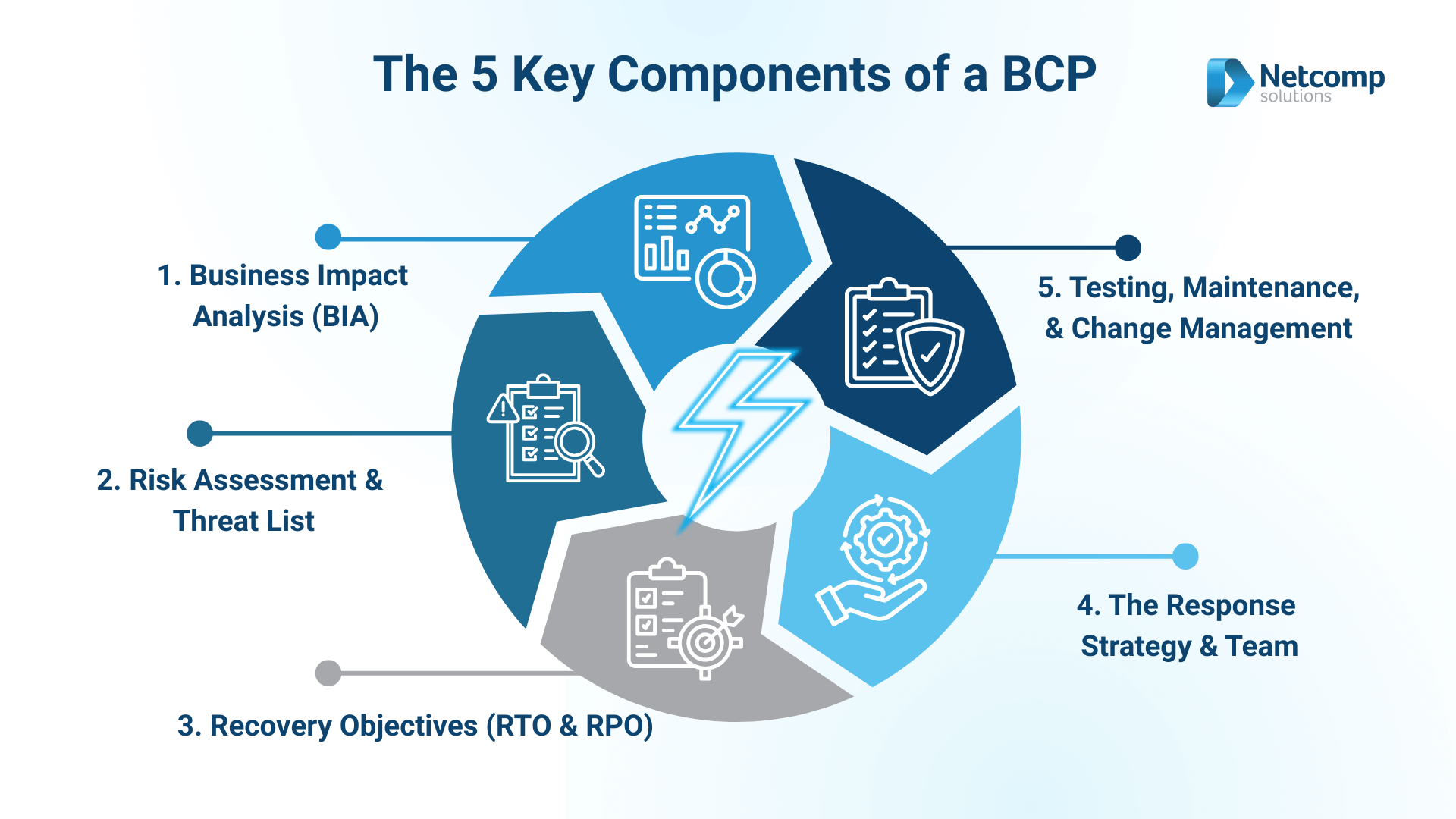Imagine arriving at your office on Monday morning to find it flooded from a burst pipe. Or discovering that a cyberattack has locked you out of all your customer data. What if a major supplier suddenly goes out of business, leaving you unable to fulfil orders? These scenarios aren’t just hypothetical nightmares—they’re real threats that Australian small businesses face every day. The critical question is: can your business continue operating when disaster strikes?
The stakes couldn’t be higher. Statistics show that the rate of failure for small businesses that suffer a major operational disruption is extremely high:
- The Stakes: After a significant data loss event or cyber attack, 60% of small businesses never reopen or close permanently.
- The Cyber Threat: The average cost per cyber crime has grown significantly for Australian small businesses. Moreover, reports indicate that direct costs average about $50,000 per incident for some, and can be even higher for those experiencing extended downtime.
Ultimately, this isn’t just about cleaning up the mess; instead, it’s about staying resilient. Hence, we view a robust Business Continuity Plan (BCP) as your essential insurance policy—specifically, the documented guarantee that your business has the blueprint to manage any crisis and continue serving your customers.
In essence, a BCP is a proactive strategy detailing how your operations will maintain or quickly resume critical business functions after any major interruption. Therefore, it is the roadmap to survival, ensuring you not only recover, but emerge stronger.
What is a Business Continuity Plan (BCP)?
A Business Continuity Plan (BCP) is simply a documented, pre-agreed strategy detailing exactly how your business will maintain its critical functions and quickly resume operations following a major disruption, such as a power outage, IT system failure, or natural disaster.
The key insight here is that a BCP is fundamentally about staying in business during and immediately after a crisis, not merely cleaning up the mess or recovering data days or weeks later. It ensures your core operations can be switched to a backup plan with minimal delay, guaranteeing resilience.
A robust BCP is designed to protect the four most vital aspects of your business:
- Data: Firstly, protecting critical information assets, including customer records, financial files, and intellectual property.
- Assets: Secondly, safeguarding physical assets like your office location, essential equipment, and hardware.
- Finance: Thirdly, maintaining cash flow and providing a clear, pre-approved budget for immediate recovery expenses to avoid closure.
- Reputation: Finally, preserving the trust and confidence of your customers, suppliers, and stakeholders by demonstrating preparedness and stability.
Blueprint for Survival: The 5 Key Components of a BCP

A Business Continuity Plan (BCP) isn’t just a stack of paperwork. Instead, it’s a practical framework that helps your business survive and recover when disaster strikes. To make it easier to understand, let’s break it down into the five essential components every small business in Australia should include. In other words, think of these as the building blocks of resilience.
1. Business Impact Analysis (BIA)
First of all, the starting point in any BCP is a Business Impact Analysis. This means identifying your Critical Business Functions (CBFs) — the activities your business simply cannot afford to stop. For example, this could be your ability to take payments, keep your website online, deliver products, or provide customer service.
After that, you’ll need to work out your Maximum Tolerable Downtime (MTD) — the longest your business can survive without each function. For instance, you might survive a 24-hour email outage, but not a week without access to your sales platform.
Ultimately, this step ensures you focus your resources on protecting what matters most.
2. Risk Assessment & Threat List
Next, every business faces risks, but not all risks are equal. Therefore, a Risk Assessment helps you identify and prioritise the threats most likely to impact your operations. Specifically for Australian small businesses, this might include:
- Cyberattacks such as ransomware or phishing scams
- Power outages or internet downtime
- Natural disasters like bushfires, floods or storms
- Staff illness or unexpected loss of key personnel
- Supply chain disruptions (e.g. delayed shipments, transport strikes, or supplier insolvency)
By documenting these risks, you’ll gain a clear picture of what could go wrong and how badly it could hurt your operations.
3. Recovery Objectives (RTO & RPO)
Once you understand the risks, the next step is setting measurable targets for getting back on track. These are called Recovery Objectives and there are two main types:
- Recovery Time Objective (RTO): How quickly you need to restore a function. For example, if your POS system goes down, your RTO might be two hours.
- Recovery Point Objective (RPO): How much data you can afford to lose. For instance, if your RPO is four hours, you’ll need to back up your data at least every four hours to avoid unacceptable losses.
Consequently, defining these objectives ensures your recovery strategy is realistic, measurable, and tailored to your business.
4. The Response Strategy & Team
When disruption hits, confusion can be just as damaging as the event itself. That’s why a BCP must include a clear response strategy and a designated continuity team.
In practice, this involves:
- Setting out roles and responsibilities for key staff
- Establishing a chain of command (who makes decisions, who communicates, who handles customers)
- Creating a communication tree so everyone knows who to call and when
For example, you might assign one manager to liaise with suppliers, another to update customers, and your IT support team (like Netcomp Solutions) to manage system recovery.
5. Testing, Maintenance, and Change Management
Finally, a plan that sits on a shelf is as good as no plan at all. Therefore, the last step is to test your BCP regularly — through tabletop exercises, drills, or simulated outages. As a result, this ensures your staff know what to do under pressure and helps you uncover gaps before a real crisis exposes them.
In addition, your plan should evolve as your business grows. Because new staff, new systems, and new risks all emerge over time, your BCP must be reviewed and updated at least once a year (or after any major change).

The Crucial Difference: BCP vs. Disaster Recovery (DR)
To put it simply, a Business Continuity Plan (BCP) and a Disaster Recovery Plan (DRP) are closely related, but they are not the same thing. Think of it this way: your BCP is like a big umbrella that keeps your whole business dry during a storm, while your DRP is just one spoke of that umbrella — specifically protecting your IT systems.
| Feature | BCP | DRP |
| Scope | People, process, communications, operations | IT systems, data, infrastructure |
| Timing | Before, during, after disruption | After disruption (restore) |
| Goal | Keep business running (at least essential functions) | Recover tech / data to acceptable state |
| Examples | Alternate premises, vendor backup, remote work | System restore, backups, server recovery |
Business Continuity Plan (BCP) – The Umbrella Strategy
First of all, a BCP is the umbrella strategy that ensures your business keeps functioning, even if disaster strikes. In practice, this might mean switching to alternative methods or processes until normal operations are restored.
- For example, if your IT system goes down, your team could still process orders manually.
- As a result, customers remain supported, and revenue keeps flowing.
In other words, a BCP is about prevention and endurance, helping your business survive disruptions of all kinds — not just IT failures.
Disaster Recovery Plan (DRP) – The IT Restoration Focus
On the other hand, a Disaster Recovery Plan is a specialised part of the wider BCP. Specifically, it focuses on restoring your IT infrastructure and data as quickly as possible.
- For instance, this includes recovering servers, databases, and network connectivity.
- Consequently, it ensures your systems return to normal and your digital operations continue.
Put simply, while the BCP keeps the entire business running, the DRP zeroes in on IT recovery. Both are essential, but together they form a complete strategy for resilience.
3 Simple, Actionable Steps to Build Your Small Business BCP
Although building a robust Business Continuity Plan can seem like a monumental task, it doesn’t have to be. For example, for a small Australian business, the goal is practical resilience. Consequently, you can start with these three focused steps today:
1. Step 1: Focus on the “Vital Few”
Crucially, don’t try to plan for every process in your company. Instead, use the Business Impact Analysis (BIA) principle to focus on your survival essentials.
- Action: List your 3 to 5 most critical business functions (CBFs). These are the activities that, if stopped, would cause your business to fail within days.
- Examples: Processing invoices, fulfilling customer orders, or paying staff/suppliers.
- The Test: For each function, answer this question: “What happens if this stops for 48 hours?” The answer, therefore, will immediately highlight where your planning must start.
2. Step 2: Create “Workarounds” (Manual Mode)
Once you know what must keep running, you then need a pre-agreed alternative method for running it without your primary systems. As a result, this is your “Manual Mode” or workaround strategy.
- Action: For each vital function identified in Step 1, define a manual or low-tech alternative. Importantly, document this clearly.
- Example 1 (IT Failure): If you lose internet access and access to your main sales platform, then instruct staff to use pen and paper for essential customer orders and promise to reconcile the data later when systems are restored.
- Example 2 (Office Closure): If your physical office is inaccessible (due to flood or fire), then designate a Work-From-Home (WFH) procedure where staff use personal mobiles or cloud tools for key calls.
3. Step 3: Keep the BCP Accessible & Test It
However, a BCP is useless if it’s locked on the server that just crashed. Therefore, ensure your plan is stored correctly and that your team knows how to use it.
- Accessibility: First, print a physical copy of the BCP’s core contact list and recovery steps and store it offsite (e.g., at the home of two key employees). Additionally, keep a copy in a separate, secure cloud location (like a protected file storage platform) that isn’t connected to your main business network.
- Testing: Second, schedule one simple annual drill. In fact, this doesn’t need to be complex. Try a “No-Email Monday” simulation where key team members must use only the communication alternatives listed in the BCP for four hours. This simple practice, consequently, builds muscle memory and reveals weaknesses far better than any theoretical discussion.
Australian Legal, Regulatory, and Compliance Considerations

When building a Business Continuity Plan, it’s easy to focus only on technology and operations. However, small businesses in Australia also need to consider legal and compliance obligations. By doing so, you’ll not only protect your operations but also avoid penalties, breaches of contract, or insurance complications.
1. Contractual and Business Obligations
First of all, your BCP must account for existing contracts and service-level agreements (SLAs).
- For example, if you’ve promised customers delivery within 48 hours, your plan needs to show how you’ll continue meeting that obligation during a disruption.
- In addition, supplier contracts and insurance policies often include specific requirements for continuity, which means failing to comply could expose your business to financial or legal risk.
2. Privacy Act and Data Breaches
Next, under the Privacy Act 1988, Australian businesses that handle personal information have strict obligations.
- For instance, if a cyberattack disrupts your business and customer data is compromised, you may be required to notify both customers and the Office of the Australian Information Commissioner (OAIC).
- Therefore, your BCP should outline how you will protect sensitive data, respond to breaches, and communicate transparently if one occurs.
3. Occupational Health & Safety (OHS)
The safety of your staff is the paramount legal responsibility during any crisis.
- Staff Safety in Crisis: The BCP must include clear, documented procedures for evacuating your premises, ensuring staff are safe during a crisis (like a fire or flood), and managing workplace hazards in temporary operating environments.
- WHS Compliance: This ensures you meet your legal obligations under state and territory Work Health and Safety (WHS) legislation, demonstrating you took all reasonably practicable steps to protect your workers.
4. Insurance Coverage and Claims
Your BCP directly affects your ability to claim under your policies.
- Business Interruption Insurance: This policy requires clear documentation proving the extent of the loss. Your BCP, particularly the Business Impact Analysis (BIA) and Recovery Objectives (RTO/RPO), provides the necessary evidence to support the claim.
- Cyber Insurance: The insurer will often require evidence of specific controls (like Multi-Factor Authentication and regular backups) outlined in your BCP before a claim is paid.
5. Recordkeeping and Audit Trails
Any process changes made during a crisis must be recorded and auditable.
- Regulatory Compliance: If you operate in a regulated sector (e.g., finance, health), your BCP needs to define how you maintain compliant records, even when manually processing data.
- Reconciliation: The plan must outline how and when all manual processes will be checked, logged, and reconciled with the permanent systems once they are restored, creating a clear audit trail.
Your Resilient Future Starts Today
A Business Continuity Plan isn’t some complex, hundred-page document reserved for large corporations with dedicated risk management teams. It’s a practical, straightforward tool that any Australian small business can create and implement. Your BCP is a living document—something you’ll update as your business grows, as new threats emerge, and as you learn from each challenge you face. It doesn’t need to be perfect from day one; it just needs to exist and be accessible when you need it most.
Don’t wait until disaster strikes to wish you’d prepared. Download a FREE template today, set aside a couple of hours this week, and start building your Business Continuity Plan. Your future self—and your employees, customers, and family who depend on your business—will thank you for it.
At Netcomp Solutions, we understand that business continuity goes hand-in-hand with robust IT infrastructure and support. If you need guidance on protecting your technology systems, implementing secure data backups, or ensuring your IT can support your continuity plans, we’re here to help Australian small businesses build resilience into every aspect of their operations.



